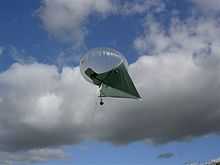Allsopp Helikite

The Helikite is a type of kite-balloon or kytoon designed by Sandy Allsopp in the UK in 1993. Allsopps UK Patent No.2280381 and US Patent No.6016998A. The Helikite comprises a combination of a helium balloon and a kite to form a single, aerodynamically sound tethered aircraft, that exploits both wind and helium for its lift.
Design
The Helikite comprises a semi-rigid helium-filled balloon, having a rigid carbon-fibre spine, with the balloon shaped aerodynamically. The balloon is generally oblate-spheroid in shape although this is not essential. Solid spars provide attachment points for payload equipment.
In most winds the aerodynamic lift is greater than the aerostatic lift from the helium.
The Helikite design is intended for all-weather, high-altitude operation. The round, stubby shape allows it to be flown in any weather or for altitudes up to 7000 ft. In wind, both the main aerodynamic lift and the aerostatic lift are at the front, while the spar weight and keel are at the stern. Therefore a Helikite remains stable in relatively high winds
For operation in extreme conditions, a ballonet may be fitted.
Classification
A Helikite is a new type of tethered aerostat with its own official classification, distinct from any type of balloon.
The US Customs classifies a Helikite as "other non-powered aircraft", while the British Civil Aviation Authority's Air Navigation Order has created its own classification as "Helikites" as distinct from "kites" and "balloons".
Customs authorities classify the Helikite as a type of kite because of the considerable positive aerodynamic uplift in wind.
Operation
Thousands of Helikites have been operated worldwide, over both land and sea.
Helikites are used for aerial photography, lifting antennas, radio-relay, advertising, agricultural bird-control, position marking, and meteorology. The military also use Helikites as jungle marker balloons, for lifting radio-relays, and raising surveillance equipment.
Helikites are the only compact aerostat capable of reliably operating at sea. For this reason small, rapid-response surveillance Helikites are part of the emergency oil-spill response system of Scandinavia for operations in the arctic ocean.
Due to their stability, Helikites are capable of successfully operating non-gyrostabilised cameras, leading to wide use by photographers and cameramen.
A small Helikite may be used as a "personal aerostat" that is small enough for one person to easily operate and yet will fly high in bad weather.
The British Army military Helikite surveillance system has 34 m³ volume and lifts a lightweight gyro camera with both E/O and IR capabilities. The US surveillance Helikites are 75m3 and carries a larger gyro camera system and targeting equipment. These aerostats outperform a conventional aerostat of twice the size. These Helikites can lift surveillance equipment above the range of small arms fire, effectively making Helikites unassailable to most common threats.
The smallest Helikite ever made was of just 0.028m3 (1 cubic ft). It flew well despite its tiny size. The largest Helikite made so far is 100m3 (3,500) cubic ft which has a net helium lift of 55 kg.
Operators include: US Navy, US Air Force, US Marines, US Navy Seals, British Army, Royal Marines, Australian Defence Force, Lockheed Martin, DSTL, QinetiQ, CENETIX, Thales, British Antarctic Survey, Norway Oil-spill Response, Sandia National Laboratories, Frauenhofer Institute, CSIR, NIWA.